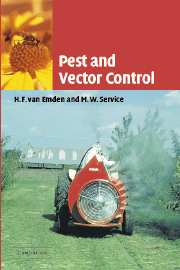Book contents
- Frontmatter
- Contents
- Preface
- 1 Man and insects
- 2 The causes of pest and vectored disease outbreaks
- 3 Insecticides and their formulation
- 4 Application of insecticides
- 5 Problems with insecticides
- 6 Environmental/cultural control
- 7 Biological control
- 8 Insect pathogens
- 9 Genetic control
- 10 Pheromones
- 11 Plant and host resistance
- 12 Other control measures and related topics
- 13 Pest and vector management
- Appendix of names of some chemicals and microbials used as pesticides
- References
- Index
5 - Problems with insecticides
Published online by Cambridge University Press: 03 December 2009
- Frontmatter
- Contents
- Preface
- 1 Man and insects
- 2 The causes of pest and vectored disease outbreaks
- 3 Insecticides and their formulation
- 4 Application of insecticides
- 5 Problems with insecticides
- 6 Environmental/cultural control
- 7 Biological control
- 8 Insect pathogens
- 9 Genetic control
- 10 Pheromones
- 11 Plant and host resistance
- 12 Other control measures and related topics
- 13 Pest and vector management
- Appendix of names of some chemicals and microbials used as pesticides
- References
- Index
Summary
Introduction
The first synthetic broad-spectrum insecticides, the organochlorines, offered a revolution in the efficacy of pest control, especially of the malaria mosquitoes and other disease vectors of mankind. Additionally they offered cheap, sure and long-lasting control of crop pests. With hindsight, we can be critical of the profligate early use of organochlorine insecticides: however, we need to remember that it is hard to predict the unforeseen. Many of man's technical advances have in the past needed, and will continue to need, modification in the light of experience. Progress will always involve risk. The wide-scale use of the early synthetic broad-spectrum insecticides, particularly certain organochlorines with the then prized characteristic of long persistence, produced certain obviously damaging side-effects. The scientific community, operating via committee structures and accurate but rather conservative memoranda through official channels, was drawing the attention of governments to these problems as early as the mid 1940s. However, the real landmark in change of attitudes and government legislation was the publication of Rachel Carson's Silent Spring in America in 1962 (Fig. 5.1). This castigation of insecticides was considerably overstated in the opinion of many scientists, but it created a public awareness and outcry of which politicians could not help but take notice. Her main criticisms, in order of the importance she gave them in the book, were the toxicity of pesticides to humans, their damaging effects on wildlife and lastly, the appearance of pest strains with tolerance to the toxins.
- Type
- Chapter
- Information
- Pest and Vector Control , pp. 107 - 122Publisher: Cambridge University PressPrint publication year: 2004



